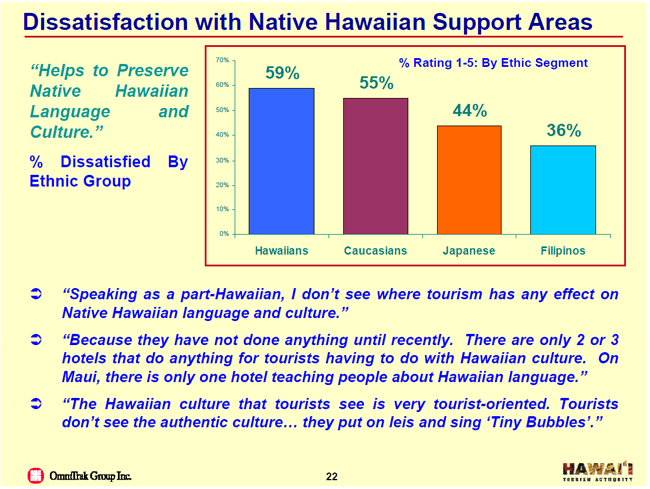After releasing the results of a survey that show the Hawaii Tourism Authority faces a reputation gap with the Native Hawaiian culture, the HTA is awarding hundreds of thousands of dollars to organizations to perpetuate Hawaiian culture.
The HTA announced that it has selected 27 programs to receive $600,000 in funding through its Kūkulu Ola – Living Hawaiian Culture Program (LHCP) in 2010. The programs were selected with guidance from the Hawaiian Cultural Program Advisory Council. Of the 27 recipients, 8 are on the Big Island.
“The Hawaiian culture is an integral part of our islands’ identity that sets us apart as a special and unique visitor destination,” said Mike McCartney, HTA’s President and Chief Executive Officer. “HTA remains committed to supporting programs that respects, perpetuates and preserves the Hawaiian culture for both visitors and residents.”
The announcement comes days after the tourism authority released the details of a recent study that found prevailing dissatisfaction with Native Hawaiian support areas.
The survey, conducted Aug. 27 through Sept. 20, 2009, found that Native Hawaiians have a lower level of support for the visitor industry and are less aware of current initiatives and support.
“Despite what the industry may be doing currently, in the public view, and especially among Native Hawaiians”, says the survey conducted by the OmniTrak Group Inc., research company, “the Visitor Industry does not have the reputation of respecting Hawaiian culture and of presenting the Hawaiian arts authentically and accurately.”

Section of HTA survey dealing with Native Hawaiian support
“We suggest strengthening current initiatives to preserve the Native Hawaiian language and cultural practices,” the survey added.
The money awarded by HTA’s Living Hawaiian Culture Program intends “to support programs that help to honor and preserve the Hawaiian culture, demonstrate collaborative efforts with a high degree of community support and involvement, exhibit depth and breadth of experience in performing similar work, and has an adequate plan for sustainability into the future.”
BIG ISLAND RECIPIENT PROGRAMS:
Māla Kalo (Bishop Museum)
This project entails the replanting of an entire collection of 70 Hawaiian kalo varieties at the Captain Cook site. An interpretive panel, workshops, and community outreach activities will be implemented. A kalo apprentice will be recruited to give poi making demonstrations at the Amy B.H. Greenwell Ethnobotanical Garden.
2010 Kamehameha Festival (Hale Mua Cultural Group, Inc.)
A one-day festival, free to the public, to honor the memory of Kamehameha and to build bridges of understanding and harmony between Hawai‘i’s host culture, multicultural community and visitors. The festival will feature hula, music, oli (chant), arts and crafts, cultural presentations, and ‘ono food.
Kohala Cultural Learning Project (Hawai‘i FFA Foundation)
This project will provide mentorship and instruction to Kohala youth and their families on traditional Hawaiian cultural practices through the propagation of Kalo and traditional saddlemaking. Youth docents and families will then be able to share this knowledge with visitors through hands-on workshops and tours.
Ka Pilina Poina ‘Ole “Connection Not Forgotten” (Hawai‘i Forest Industry Association )
This one-year cultural education and volunteer stewardship program at Ka‘ūpūlehu Dryland Forest and Kalaemanō Cultural Center in North Kona will include cultural talk stories sessions, interpretive audio stations and brochures, learning guides, and Web resources.
Ola ‘Ai‘ōpio (Hui Ho‘oniho)
The goal of this project is to complete various studies to satisfy an environmental assessment for a three-year project to rehabilitate ‘Ai‘ōpio Fishtrap, located in Kaloko-Honokōhau National Park. Experts in biology and archaeology will be consulted for these studies.
Hawaiian Featherwork: Lei Hulu of Hilo (Lyman Museum)
Installation of a full exhibit of lei hulu and other examples of Hawaiian featherwork at the Lyman Museum’s main building to honor, support and perpetuate this unique Hawaiian art form and its cultural practioners. Demonstrations by cultural practitioners of the art, and training of museum staff and docents will also be implemented.
Ho‘oku‘ikahi i Pu‘ukoholā Heiau 2010 (Nā ‘Aikane o Pu‘ukoholā Heiau)
The goal of this project is the restoration of Pu‘ukoholā Heiau, one of the highest visitor attractions on Hawai‘i Island. Workshops will be conducted to create implements and vestments for ceremonies, docents will be trained for eco-tours of the site, and signage for native plants will also be installed.
Puana Ka ‘Ike and Lā ‘Ike (The Kohala Center)
This goal of this lecture series at Kahalu‘u Bay and other locations around the island is to provide accurate information about authentic Native Hawaiian knowledge and practices with high quality speakers, presentations, and demonstrations in a setting that welcomes residents and visitors alike. Selected lectures and presentations will be videotaped in order to reach a broader audience through webcasting and DVDs.
New Patient Safeguards for Online Drugstore Prescriptions. Part 2

by Big Island Video News11:33 pm
on at
STORY SUMMARY
After releasing the results of a survey that show the Hawaii Tourism Authority faces a reputation gap with the Native Hawaiian culture, the HTA is awarding hundreds of thousands of dollars to organizations to perpetuate Hawaiian culture. The HTA announced that it has selected 27 programs to receive $600,000 in funding through its Kūkulu Ola […]